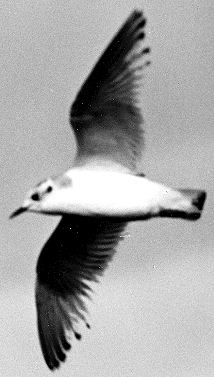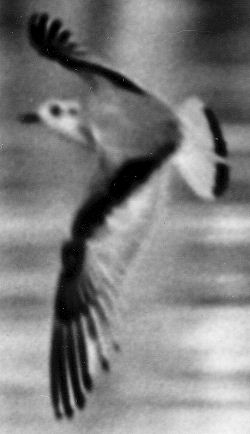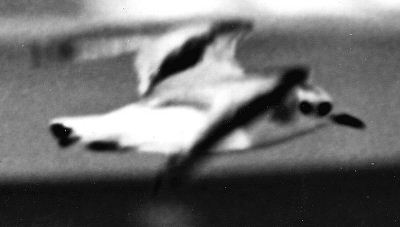
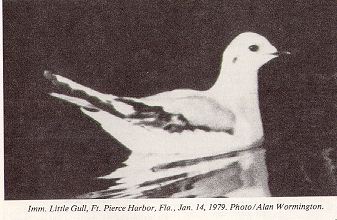
Here's the spread wing of juvenile/first-basic Little Gull
(LIGU; left) and Ross's Gull (ROGU: right) - by Martin Reid:
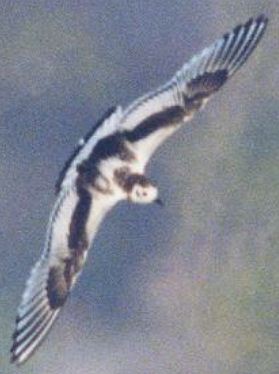
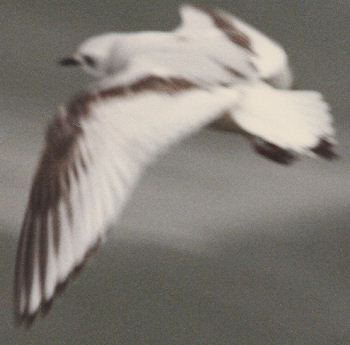
- on LIGU the outer web of P10 - P5 is dark from the tip to the
coverts (sometimes P5 has a small break near the tip), but on
ROGU the dark on the outer web reaches the tip on P10 - P8 only,
with P7 having a short subterminal section where just the thin
shaft is dark; this effect is repeated to a greater extent on
P6, and P5 is virtually all-pale with a dark tip. Note also that
the dark tips to these primaries on LIGU are thick on the outer
web of each feather, yet thin on the inner web; the LIGU shown
above is a juvenile, and during the winter, wear can cause the
tips to lose the black on most of the inner web. On ROGU the black
tip to each outer primary is more evenly thick, such that the
tip normally remains black across both webs.
The consequences of this outer primary pattern on the folded
wing is distinctive: LIGU always has an unbroken dark stripe along
the outer half, from the wingtip to the primary coverts; the inner
half varies, and on worn individuals much white is visible, usually
creating a white saw-tooth effect that occupies half the width
of the primaries (follow
this link to see a standing juv. LIGU at Frode Falkenberg's
site; other photos showing this saw-tooth pattern on LIGU are:
'Stokes Field Guide to Birds - Eastern Region', Page 195;
'The Complete Reference - Seabirds of the World'
by Enticott and Tipling, page 181).
On ROGU a saw-tooth pattern can also be seen, but the white part
is thinner (due to larger black primary tips) and occupies at
best a quarter of the width of the primaries, and importantly,
beyond the tertials there is at least one black primary tip
that is isolated by white (due to the solid white area behind
the tip of P6 and P5); often there are two isolated tips visible.
In 'GULLS - a guide to identification', Peter Grant illustrated
first-basic birds of both species in Fig. 34 ( page 118), and
although his LIGU shows no "saw-tooth" pattern, it does
show the unbroken, even black band along the entire folded wing;
the ROGU next to it shows the isolated inner primary black tips.
Below is a first-alternate ROGU by Tony Collinson, photographed
in England in June 1994, courtesy of BIRDING
WORLD magazine:
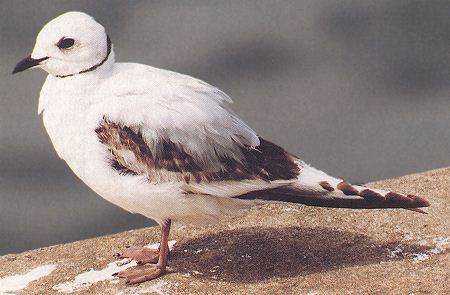
on this enlargement we can see that the tips of P5 and P6 are
isolated from the rest of the black part of the folded primaries:

Thanks to Paul Archer for these images of a 1B ROGU from Galway,
Ireland in January 2000:
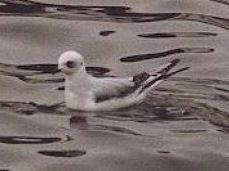
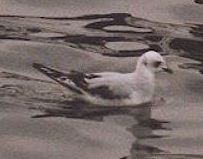

For an example of a normal pattern,
look
here at FONT's web site. Follow
this link to Cameron Eckert's juvenile ROGU, and you'll see
that the dark tip of P5 is virtually isolated by two broad pale
bands, even on this strongly-marked individual. There is always
an exception to every rule, and perhaps this
unusual juvenile ROGU at the Ujihara's site is one; in fact
I find this a most odd bird, as the long, very pale legs are more
like LIGU, and the tail does not appear to have much of a wedge
shape - I am starting to tink that this is an unusual Little Gull - comments?
The apparent lack of a dark cap on the Florida bird is
unusual, but not unheard-of, for LIGU; I refer you to photo 525
on page 128 of 'Seabirds of the World - a photographic guide'
by Harrison - this shows a January 1B LIGU that appears to lack
a dark cap (however the photograph is slightly overexposed - like
the Florida image). The book referenced above by Enticott and
Tipling also has a photo of a bird with a very faint cap (plate
5, page 181)
In the lone image of the Florida bird, there is a glint of sunlight
on the bill, and it seems to be at the tip of the bill - which
would make for an extremely short bill - perhaps too short even
for ROGU? Here is an enlargement of the head (taken from the original
smaller scan supplied by Andrew Kratter, thus much detail is lost
in the process):
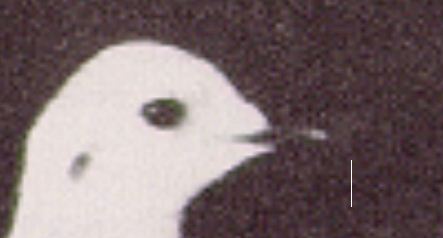
- I have added a white line pointing to where I think the tip
of the bill might be; hopefully the original photograph will clarify
this for us.
ROGU in all plumages normally shows a "neckline" effect; in summer this is formed by a thin black ring, while in winter there are traces of this ring (even in first-basic plumage) plus an abrupt change from white to pale gray where the ring would be on the neck (look again at Paul Archer's photos above, and follow this link to Frode Falkenberg's site for a first-basic ROGU in January). The Florida photograph is a bit overexposed, and it is possible that this is masking the neckline effect, but it is clear that no such neckline is apparent, nor is there any gray visible above the mantle.
On ROGU the tail is strongly wedge-shaped and has black restricted
to the central retrices, with R5 and R6 lacking any black (and
R3 almost so). LIGU has a squarish white tail with a black subterminal
band, with the outer web of R6 white, often the whole of R6 completly
lacks any black, and rarely R5 can also lack any black. Thus,
the white sides to the tail in the Florida photo do not assist
in identification; the shape of the tail appears more square-cut
and LIGU-like; also it looks rather short - on ROGU the visible
black would be at the tip of the central wedge, and thus closer
to the primary tips (follow
this link to the Ujihara's web site for an example).
In summary, I feel that the circumstances of this image (dark
background, overexposed) combine to make this bird look unusual,
but:
- the bill length/shape is not clearly discernable from this scanned
image.
- the lack of a visible crown cap does not rule out LIGU, and
could be caused by the overexposed image.
- the tail appears too short and square for ROGU, and the pattern
is inconclusive.
- the lack of a neckline could be explained by the overexposed
image, but the color-shift from pale gray to white seems to be
at the mantle line rather than higher up the neck.
- the extensive white '"saw-tooth" pattern on
the inner side of the primaries is better for LIGU than ROGU.
- the solid black wing panel from wingtip to coverts is normal
for LIGU but exceptional for ROGU.
Conclusion:- the bird is a Little Gull.
Update: February 25, 2001: three new images of the Florida Little
Gull:
